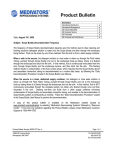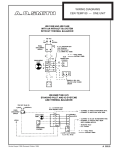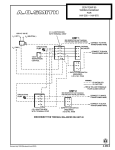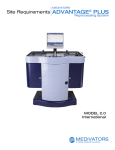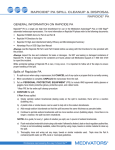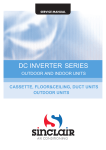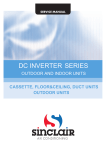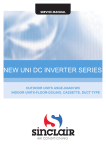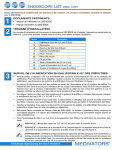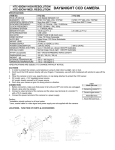Download 50097-076 Rev A
Transcript
SYSTEM OPERATION IN-SERVICE GUIDE CER-1 & CER-2 Run the Reprocessing Cycle 1. Close CER lid and secure using lid locks 2. Cycle Selection: Automatic FULL or LCG/RINSE 3. Confirm Time Settings: Wash and LCG 4. Select START to begin cycle 5. Basin thermometer HLD temperature verification Complete the Reprocessing Cycle 1. Verify STOP LED now illuminated 2. Alcohol Flushing Port w/air on (Manual, air/10, Start) 3. Record Endoscope Cycle completion in Log 4. Disconnect hook up and remove and store reprocessed endoscope(s) and hook up(s) End of Day Shutdown 1. Water Supply Valve: End of Day “OFF” 2. Clean basin, lid and gaskets (Use lint-free cloth) FOR FACILITY USE ONLY Staff Name: MAINTENANCE TROUBLESHOOTING Weekly Maintenance Troubleshooting 1. Clean CER reprocessor and basin (use lint-free cloth) 2. Inspect CER reprocessor and hook-up components for wear and tear 3. Lubricate O-rings with silicone oil 1. Review troubleshooting section in CER User Manual 2. Service Contract Coverage and Loaner Repair Program Training Date: Trainer: Monthly (as specified) 1. 1.0 micron water pre-filter (replace every 3 months or if below 40 PSI) 2. 0.2 micron absolute filter (replace every 6 months or if below 40 PSI) 3. Installation and disinfection of filters and filter housing (upon 0.2 micron filter replacement) 4. Active Vapor Management System (if applicable): Charcoal filter (replace every 6 months) Medivators Website “Resource Center” Go to: www.minntech.com/medivators, Select “Resource Center” and “User Library” for detailed user guides and hook up matrices, report forms and logs, and product bulletins Medivators Customer and Technical Support Toll Free: Phone: 1-800-444-4729 · FAX: 1-866-421-7696 Endoscope reprocessing the way it should be © MINNTECH CORPORATION All rights reserved. 50097-076/A MEDIVATORS OPERATOR CONTROLS INTENDED USE AND GUIDELINES Intended Use 1. CER Endoscope Reprocessor - High-level disinfection of flexible immersible endoscopes 2. Operator Safety Overview - appropriate PPE: mask, gown, gloves, eye protection Guidelines for Reliable Disinfection 1. Detergent solution - used in wash cycle, must be low-foaming, free-rinsing, neutral in pH and diluted per manufacturer’s recommendation 2. Disinfectant solution - required for high-level disinfection cycle. 3. Olympus®, Pentax®, Fujinon®, Storz® - Endoscope cleaning and disinfection guidelines 4. SGNA, ASGE, ASTM, APIC and AORN - Endoscope cleaning and disinfection guidelines 5. SGNA Approved Reprocessing Steps - Endoscope bedside pre-cleaning, leak testing, manual cleaning, high-level disinfection, final drying and storage standards and guidelines PRODUCT FAMILIARIZATION 1. Automatic Operaton: FULL Cycle 2. Automatic Operation: LCG/Rinse Cycle 3. LCG Time 4. Air: 10 minutes 5. Manual Operation: LCG In 6. Manual Operation: LCG Out 7. Manual Operation: Drain 8. LED’s Blinking 9. Start 10. Stop 11. Alarm Reset: LCG and Water Level Verification 12. Alcohol Flush 13. Cycle Counter Endoscope Reprocessor Components and their Functions 1. CER Front Panel: Control panel (keypads and LED indicators), cycle counter and alcohol flushing port 2. CER Basin: Lid and lid locks, channel connectors / endoscope hookup, fluid level sensor, drain screen and cover, and basin thermometer (if applicable) 3. CER Side Panel: AC electrical connection, On/Off power switch 4. CER Rear Panel: Water Inlet, Drain, Solution In and Solution Out connections 5. Disinfectant Reservoir: Tubing connections, AC power, temperature control and display 6. Water Filtration System: 1.0 micron pre-filter and 0.2 micron absolute filter 7. CER Cart (if applicable) 8. Transfer Pump (optional) 9. Active Vapor Management System (if applicablel) Fluids 1. High-Level Disinfectant (HLD) - Rapicide® HLD, OPA or Glutaraldehyde 2. Detergent (optional) - recommended detergent is Medivators Intercept® 3. Alcohol (70% isopropyl) - used to dry inside of endoscope channels 4. Test Strips - used to test the HLD prior to each cycle FLUID LOADING AND UNLOADING High-Level Disinfectant (HLD) 1. Amount of HLD disinfectant required: 4 gallons for CER-1, 5 gallons for CER-2 2. Loading disinfectant reservoir using Transfer Pump 3. Unloading disinfectant reservoir using Transfer Pump 4. Loading disinfectant reservoir using manual method 5. Unloading disinfectant reservoir using manual method 6. Setting/Adjusting disinfectant reservoir temperature (for heated disinfectant) 7. Disinfectant neutralization and disposal (optional) 8. Cleaning the disinfectant reservoir SYSTEM OPERATION Start-up 1. Verify power is on Daily Service 1. Perform Daily Quality Assurance Procedure 2. Water Supply Valve: Start of day “ON” 3. Water Flow Verification: 100cc’s (4 oz) in less than 15 seconds through each hook up port 4. Air Flow Verification: Confirm vigorous bubbling from each hook up port 5. Verify disinfectant level in reservoir 6. Check disinfectant reservoir temperature (2°C higher in reservoir for correct basin temp) 7. Check HLD expiration date, temperature and potency level with test strips 8. Check drain screen and cover for debris 9. Inspect hook ups for wear Prepare Endoscope for Reprocessing 1. Place endoscope control section in lower right with light guide in the back middle 2. Place accessory bag into basin away from drain 3. Locate proper hook up and connect hook up to endoscope ports and basin connection Endoscope Reprocessing Cycle Summary 1. Wash Phase (optional) 2. Rinse Phase 3. Disinfection Phase 4. Rinse Phase (2 if using Rapicide or Glutaraldehyde, 3 if using OPA) 5. Air Purge Phase 6. Manual Alcohol Flush Phase Endoscope reprocessing the way it should be MEDIVATORS OPERATOR CONTROLS INTENDED USE AND GUIDELINES Intended Use 1. CER Endoscope Reprocessor - High-level disinfection of flexible immersible endoscopes 2. Operator Safety Overview - appropriate PPE: mask, gown, gloves, eye protection Guidelines for Reliable Disinfection 1. Detergent solution - used in wash cycle, must be low-foaming, free-rinsing, neutral in pH and diluted per manufacturer’s recommendation 2. Disinfectant solution - required for high-level disinfection cycle. 3. Olympus®, Pentax®, Fujinon®, Storz® - Endoscope cleaning and disinfection guidelines 4. SGNA, ASGE, ASTM, APIC and AORN - Endoscope cleaning and disinfection guidelines 5. SGNA Approved Reprocessing Steps - Endoscope bedside pre-cleaning, leak testing, manual cleaning, high-level disinfection, final drying and storage standards and guidelines PRODUCT FAMILIARIZATION 1. Automatic Operaton: FULL Cycle 2. Automatic Operation: LCG/Rinse Cycle 3. LCG Time 4. Air: 10 minutes 5. Manual Operation: LCG In 6. Manual Operation: LCG Out 7. Manual Operation: Drain 8. LED’s Blinking 9. Start 10. Stop 11. Alarm Reset: LCG and Water Level Verification 12. Alcohol Flush 13. Cycle Counter Endoscope Reprocessor Components and their Functions 1. CER Front Panel: Control panel (keypads and LED indicators), cycle counter and alcohol flushing port 2. CER Basin: Lid and lid locks, channel connectors / endoscope hookup, fluid level sensor, drain screen and cover, and basin thermometer (if applicable) 3. CER Side Panel: AC electrical connection, On/Off power switch 4. CER Rear Panel: Water Inlet, Drain, Solution In and Solution Out connections 5. Disinfectant Reservoir: Tubing connections, AC power, temperature control and display 6. Water Filtration System: 1.0 micron pre-filter and 0.2 micron absolute filter 7. CER Cart (if applicable) 8. Transfer Pump (optional) 9. Active Vapor Management System (if applicablel) Fluids 1. High-Level Disinfectant (HLD) - Rapicide® HLD, OPA or Glutaraldehyde 2. Detergent (optional) - recommended detergent is Medivators Intercept® 3. Alcohol (70% isopropyl) - used to dry inside of endoscope channels 4. Test Strips - used to test the HLD prior to each cycle FLUID LOADING AND UNLOADING High-Level Disinfectant (HLD) 1. Amount of HLD disinfectant required: 4 gallons for CER-1, 5 gallons for CER-2 2. Loading disinfectant reservoir using Transfer Pump 3. Unloading disinfectant reservoir using Transfer Pump 4. Loading disinfectant reservoir using manual method 5. Unloading disinfectant reservoir using manual method 6. Setting/Adjusting disinfectant reservoir temperature (for heated disinfectant) 7. Disinfectant neutralization and disposal (optional) 8. Cleaning the disinfectant reservoir SYSTEM OPERATION Start-up 1. Verify power is on Daily Service 1. Perform Daily Quality Assurance Procedure 2. Water Supply Valve: Start of day “ON” 3. Water Flow Verification: 100cc’s (4 oz) in less than 15 seconds through each hook up port 4. Air Flow Verification: Confirm vigorous bubbling from each hook up port 5. Verify disinfectant level in reservoir 6. Check disinfectant reservoir temperature (2°C higher in reservoir for correct basin temp) 7. Check HLD expiration date, temperature and potency level with test strips 8. Check drain screen and cover for debris 9. Inspect hook ups for wear Prepare Endoscope for Reprocessing 1. Place endoscope control section in lower right with light guide in the back middle 2. Place accessory bag into basin away from drain 3. Locate proper hook up and connect hook up to endoscope ports and basin connection Endoscope Reprocessing Cycle Summary 1. Wash Phase (optional) 2. Rinse Phase 3. Disinfection Phase 4. Rinse Phase (2 if using Rapicide or Glutaraldehyde, 3 if using OPA) 5. Air Purge Phase 6. Manual Alcohol Flush Phase Endoscope reprocessing the way it should be MEDIVATORS SYSTEM OPERATION IN-SERVICE GUIDE CER-1 & CER-2 Run the Reprocessing Cycle 1. Close CER lid and secure using lid locks 2. Cycle Selection: Automatic FULL or LCG/RINSE 3. Confirm Time Settings: Wash and LCG 4. Select START to begin cycle 5. Basin thermometer HLD temperature verification Complete the Reprocessing Cycle 1. Verify STOP LED now illuminated 2. Alcohol Flushing Port w/air on (Manual, air/10, Start) 3. Record Endoscope Cycle completion in Log 4. Disconnect hook up and remove and store reprocessed endoscope(s) and hook up(s) End of Day Shutdown 1. Water Supply Valve: End of Day “OFF” 2. Clean basin, lid and gaskets (Use lint-free cloth) FOR FACILITY USE ONLY Staff Name: MAINTENANCE TROUBLESHOOTING Weekly Maintenance Troubleshooting 1. Clean CER reprocessor and basin (use lint-free cloth) 2. Inspect CER reprocessor and hook-up components for wear and tear 3. Lubricate O-rings with silicone oil 1. Review troubleshooting section in CER User Manual 2. Service Contract Coverage and Loaner Repair Program Training Date: Trainer: Monthly (as specified) 1. 1.0 micron water pre-filter (replace every 3 months or if below 40 PSI) 2. 0.2 micron absolute filter (replace every 6 months or if below 40 PSI) 3. Installation and disinfection of filters and filter housing (upon 0.2 micron filter replacement) 4. Active Vapor Management System (if applicable): Charcoal filter (replace every 6 months) Medivators Website “Resource Center” Go to: www.minntech.com/medivators, Select “Resource Center” and “User Library” for detailed user guides and hook up matrices, report forms and logs, and product bulletins Medivators Customer and Technical Support Toll Free: Phone: 1-800-444-4729 · FAX: 1-866-421-7696 Endoscope reprocessing the way it should be © MINNTECH CORPORATION All rights reserved. 50097-076/A MEDIVATORS




